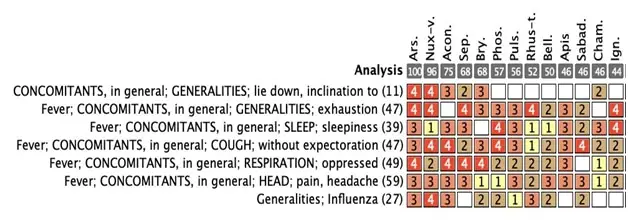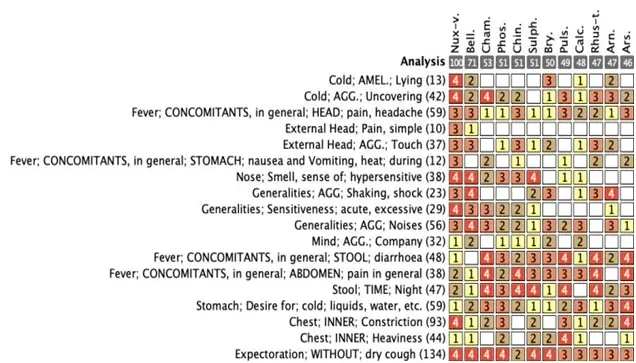Dear Colleagues,
Many of you, concerned about this virus epidemic, have contacted me for advice. I was not able to respond with any specific advice as I did not have the details of cases to work from. However, now with more time, this is coming out.
Today there was an article in the Homeopathy for Everyone online journal, “Homeopathy for Coronavirus Covid-19 Infection” which describes the symptoms of several cases. This is very useful as we can then, as Hahnemann tells us to do, combine the cases and look for the most characteristic symptoms.
The authors of the article suggest that the genus epidemicus may be Camphora but I am doubting it as they are having to give it as Camphora 1M every 5 hours for days. My thinking it that if it were the genus epidemicus, one dose would be sufficient. If they are finding this necessary, then it is palliation.
Let’s you and I look at it freshly.
Symptoms from Cases
I will not list all the symptoms here as it’s not necessary. Many, as expected, are common ones of most infectious diseases and therefore of little value in identifying a remedy. What I will list here are the symptoms that were seen in most cases, with emphasis on those that will be characteristic.
- Malaise; tired, wants to lie down
- Prostration
- Sleepiness
- Soreness of body; aching
- Fever
- Perspiration
- Chill
- Dry cough; > lying
- Dyspnea, especially on physical activity
- Headache
- Appetite decreased; nausea
- Moaning
- Sense of smell increased
- Skin sensitive to touch
The most characteristic symptoms are in bold.
This pattern is very much like what we call flu. Here is how the Free Medical Dictionary defines influenza:
“An acute infectious respiratory disease, caused by Influenza viruses, which are in the family Orthomyxoviridae, in which the inhaled virus attacks the respiratory epithelial cells of those susceptible and produces a catarrhal inflammation; characterized by sudden onset, chills, fever of short duration (3-4 days), severe prostration, headache, muscle aches, and a cough that usually is dry and may be followed by secondary bacterial infections that can last up to 10 days. The disease commonly occurs in epidemics, sometimes in pandemics, which develop quickly and spread rapidly; the mortality rate is usually low, but may rise in patients with secondary bacterial pneumonia, particularly in old people and those with underlying debilitating diseases; strain-specific immunity develops, but mutations in the virus are frequent, and such immunity usually does not affect antigenically different strains.”
We can recognize the similarity — the suddenness, affecting the respiratory system, fever, severe prostration, headache, muscle aches, dry cough. This disease we call flu, used to be called “grippe” in the older medical terminology — in case you are looking for this disease in the older references. We could start with the rubric for influenza.
Generalities; Influenza (27) : Acon., arn., Ars., bapt., bell., bry., camph., Caust., chel., chin., cimic., EUP-PER., gels., ip., MERC., NUX-V., phos., phyt., puls., Rhus-t., sabad., sang., sil., spig., squil., stict., verat-v.
We can see the most prominent remedies for this condition, which is a hint. But rather than start with this, let’s try an analysis emphasizing the reported symptoms, especially giving importance to those most characteristic.
Using the Böenninghausen repertory

When I see a related pair as we do with Nux and Sepia, which are complementary remedies, it is often a very good guide. Nux being the acute remedy and Sepia the deeper, more chronic, remedy shows us how similar these remedy patterns are to this condition. Hahnemann tells us, in advising us as to the treatment of epidemics, that the genus epidemicus will be the same in all cases as they first begin to manifest but if the disease progresses or is addressed later, then other remedies will be needed — such as Sepia.
In this next analysis I added in the rubric for influenza just to see if it changes anything.

Arsenicum is the highest-ranking remedy but does not seem to fit the pattern described in the cases in a larger sense as we know that Arsenicum will be chilly, thirsty, anxious, restless, and we don’t see that in what is described.
We do see similarity to Nux in the reporting of “sense of smell increased; skin sensitive to touch.” Enhanced sensitivity very characteristic of Nux. It also has the characteristic of moaning during the fever, a rubric with only 13 remedies in Kent’s repertory. So worth considering this remedy, wouldn’t you say?
From Hering’s Guiding Symptoms, for Nux Vomica
Fever
“Typhoid fever, early period, vertigo, pressing headache, particularly in forehead, bitter taste, tongue generally moist and clean, pressure in epigastrium, little or no thirst, prostration in limbs, constipation, restless sleep, disturbed by dreams, alternate chilliness and heat, chilliness on slightest movement, dryness of front of mouth and tip of tongue, intolerance of impressions of external senses, great sensitiveness to open air, thirst, with aversion to water, strong desire to lie down and considerable relief on doing so.”
Note: We see here the headache, bitter taste (which some patients reported), prostration of body, strong desire to lie down.
Nervous System
Feeling as if bruised all over.
Sensation of heaviness of body, alternating with sensation of lightness.
General languor, inclination to sit or lie down and be alone.
Sudden failing of strength, great weariness, greater in morning after rising than in evening on going to bed.
Respiration
On motion or exertion, constriction of chest and dyspnoea, must stand still, suffocative constriction of chest in evening on attempting to step into bed, must sleep sitting in a chair, very severe attack after midnight towards morning, cannot sit, severe dyspnoea, constriction and oppression of chest as of a heavy load, attacks last several hours, during which time he supports himself by leaning with hands upon table, slow, loud, whistling respiration, severe dry cough, shocks causing pain in head and abdomen, anxiety, sense of suffering throughout body, suffers from gastric troubles.
Note: This breathing difficulty is very characteristic of the epidemic, the symptom of most concern. Nux has this “difficulty breathing, worse with exertion” which is very significant. There are other symptoms in Hering’s that match but this gives you an idea. You can read it for yourself if you are interested.=
Genus Epidemicus
Am I then theorizing that Nux vomica is the genus epidemicus? Yes, that is what I am thinking. Mind you, I have not treated this or know of anyone using this remedy in treatment but this is how I work it up and therefore I’m sharing it with you. If any of you do find it of use, please let me know.
Sepia
What about Sepia? It is the complementary remedy to Nux. Would it fit the cases? If you read it over in Hering you will find that it does match, especially as to respiratory symptoms — even extending to pneumonia as a possibility. It has the difficulty breathing and many expressions of severe cough. It is even in the rubric for “cough better lying down.” It has the fever and most of the other symptoms we are considering, so no wonder that it comes up high in our analysis. Considering this, I can see it very possible that a coronavirus case could develop into a Sepia state if not treated with Nux in time to prevent this.
Conclusion
The experience of Hahnemann, Kent, and the many practitioners that dealt with epidemics show us that there is one remedy, perhaps two, that will be the genus epidemicus. This is because the essence (the wesen) of the epidemic is the same for all affected. This distinguishes it from the usual illness which is unique to each individual. Historically, the remedies found appropriate are common ones to our work and it fits into the possibility that Nux vomica is the one we need. In any case, let us hope that this problem will be easily solved by homeopathy with the added advantage of, once again, showing how effective homeopathy is in epidemics.
UPDATE
I have had a number of very helpful responses. One in particular from a colleague that experienced this condition and was able to provide the details we know are useful in homeopathic prescribing. I took this case as a fresh workup and still come up with Nux as the most indicated remedy.
Here are the symptoms provided:
Sudden onset of chills, better wrapped up and lying down, followed by fever
Headache with fever
Painful scalp when hair touched
Nausea with desire to vomit though never did
Smell of food nauseating and increased sense of smell to bad odors that
aggravated nausea
Sensitive to slightest movement of bed when lying down
Desire to be alone—sensitive to noise of others
Fever remittent—low fever, malaise and nausea/liquid diarrhea one weekend
followed by intermittent low-grade headache over a week followed by a more
significant sudden fever the following weekend (no nausea but significantly
worse diarrhea and abdominal pain)—see below
Desire to drink ice cold water frequently in small amounts (this occurred during
my initial fever with nausea)
Liquid diarrhea evacuated with straining with significant lower abdominal
pain—multiple episodes in the middle of the night (after midnight)
Feeling of constriction and heaviness over chest with no breathing difficulty
Dry cough
I worked up all these as much as I could. Some of the detail I could not find in the repertory but most of it is included. Interesting that it still came up emphasizing Nux vomica so strongly. Surely a remedy to consider.








I am a nurse and the few cases I have seen often have the extreme bloodshot eyes. Nux V. seems to also fit this symptom.
Hello
My experience of Covid 19 I have seen two remedies emerging Phosporous and Bryonia both used in 200 potencies. however as the viurs symptoms are changing constantly during the critical time other remedies have been used. One patient on the point of being taken to hospital repeated phosphorous every 15 min until normal breathing resumed. She was breathing normally in half anhour. She has made full recovery but I treated her daily over a 3 week period. She has been my most serious patient.
ARS, CAMPHORA, NUX ….SO MANY BUT NOTHING TO BE SURE. BUT ONE THING IS SURE THAT AFTER SYMPTOMS DEVELOPS, WHICH MAY BE DIFFERENT IN DIFFERENT IN INDIVIDUAL & LOCALITY, HOMEO REMEDIES WORKS WONDERFULLY AS IN OTHER VIRAL DISEASES. PEOPLE N GOVT MUST ADD THIS THERAPY IN TREATMENT OF CORONA PATIENTS.
Why are we in hurry to declare a remedy as genus epidemic us, with ones own name without even knowing head and tail of the disease, noting some set of symptoms which suits oneself and declaring a name ..We are told be Unprejudiced
Lets first draw a route map to know what’s to be cured in a case ,and than see what’s that in your remedy which would cure it
Hello doctor,
Please go through Introduction to camphor in materia medica pura by Hahnemann, which says…
“When the influenza endemic in Siberia comes among us, as it does occasionally, when the hot stage has already commenced, camphor is of service, only as a palliative, seeing that the disease is one of short duration. It should be given in frequent but ever increasing doses, dissolved in water as above described. It does not shorten the duration of the disease, but renders it much milder, and hence it conducts the disease innocuously to its termination. (On the other hand, nux vomica, in a single dose, and that the smallest possible, will often remove the disease homoeopathically in a few hours.)”
Link https://homeopathybooks.in/materia-medica-pura-samuel-hahnemann/camphora/
Why not consider Oscilllococcinum 200?
Whenever Nux is the first remedy in analysis I doubt that I have chosen well the “particular symptoms”, because Nux is a polychrest (a remedy well known and the materia medica books contains therefore more symptoms) and that makes the repertorisation so difficult.
But in this case I agree with your analysis, because Nux has this vulnerability of the lungs, the desire for warm, for being alone and the sensitivity to noise. Also it is a good remedy describing modern society, over flooded with impressions from media and technology, sitting habits, not going out for a walk (which is aggravated by the lockdown even more).